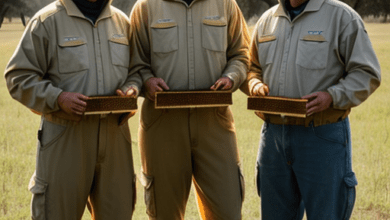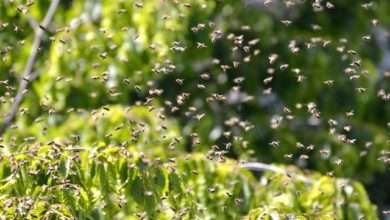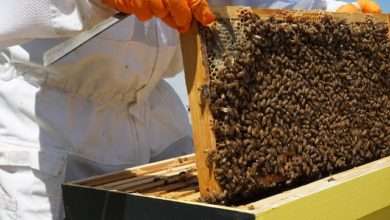The Different Types of Honey Bee Feeders
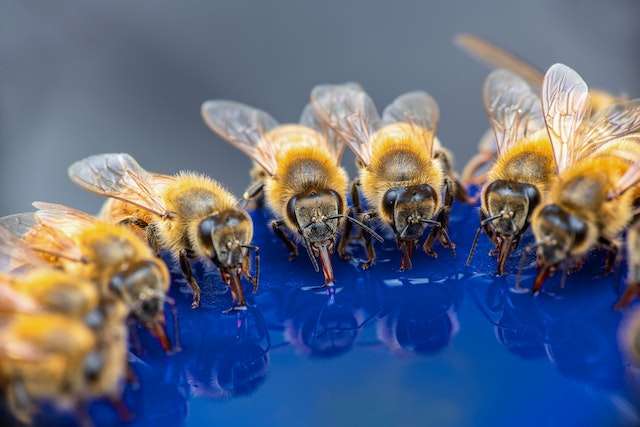
Honey bees are an essential part of our agricultural system, pollinating flowers and providing us with the delicious honey we love. But these busy little workers require regular nourishment to stay healthy and productive. That’s why it’s important for beekeepers to provide their colonies with a variety of reliable and sustainable feed sources.
From automatic feeders to natural pollen substitutes, there are several types of honey bee feeders available on the market. In this article, we’ll explore the different types of feeders to help beekeepers make informed choices about what type of feeder is best for their setup.
Importance of Honey Bee Feeders for Beekeepers
Honey bee feeders serve a crucial role in beekeeping by supplying supplemental food to honey bee colonies. They act as a lifeline during periods when natural food sources may be limited, such as in late winter or early spring when flowering plants are scarce.
Moreover, feeders are useful tools for beekeepers who aim to stimulate colony growth, increase honey production, or nurse weak colonies back to health after stressful events like swarming or transportation.
By providing additional nutrition, feeders help maintain strong, vibrant colonies that are better equipped to resist diseases and pests. These feeders are designed to improve overall hive health and honey bee vitality, ensuring the success and longevity of our beloved honey bee communities.
This article explores the various types of honey bee feeders, discussing their descriptions, purposes, and the pros and cons associated with each category. By understanding these feeders, beekeepers can make informed decisions on the most suitable option for their colonies.
Internal Feeders
Internal feeders are bee feeders that are placed inside the hive, providing easy access for the bees. They offer several benefits but also present certain drawbacks. Let’s delve into the details:
- Description and Purpose:
Internal feeders are designed to allow bees to access feed from within the hive itself. They are typically placed on top of the brood chamber or near the cluster, encouraging the bees to feed without leaving the hive. These feeders are advantageous as they minimize the risk of attracting other insects or robbing from neighboring colonies
- Pros and Cons:
Internal feeders offer several advantages, such as minimal disturbance to the hive during feeding, reduced potential for bees to drown in the feeder, and protection from external predators. However, they may require the beekeeper to open the hive for refilling or inspection, which can cause some disturbance.
Additionally, certain internal feeders can occupy space that would otherwise be used for brood rearing or honey storage.
Popular Subtypes:
- Boardman Feeders: These feeders are externally accessible, with a jar or bottle filled with syrup inserted into an entrance feeder on the hive’s exterior. They provide an easy solution for initial feeding or emergency situations but are not suitable for long-term use due to the risk of attracting robbing bees.
- Division Board Feeders: Placed parallel to a frame in the hive, division board feeders provide a reservoir for feeding within the hive. They offer a larger capacity and reduce disturbance as they can be refilled from outside the hive.
- Frame Feeders: Designed to fit within a hive frame, frame feeders minimize disturbance during feeding. They can hold a significant amount of feed but may require the removal of honey supers.
External Feeders
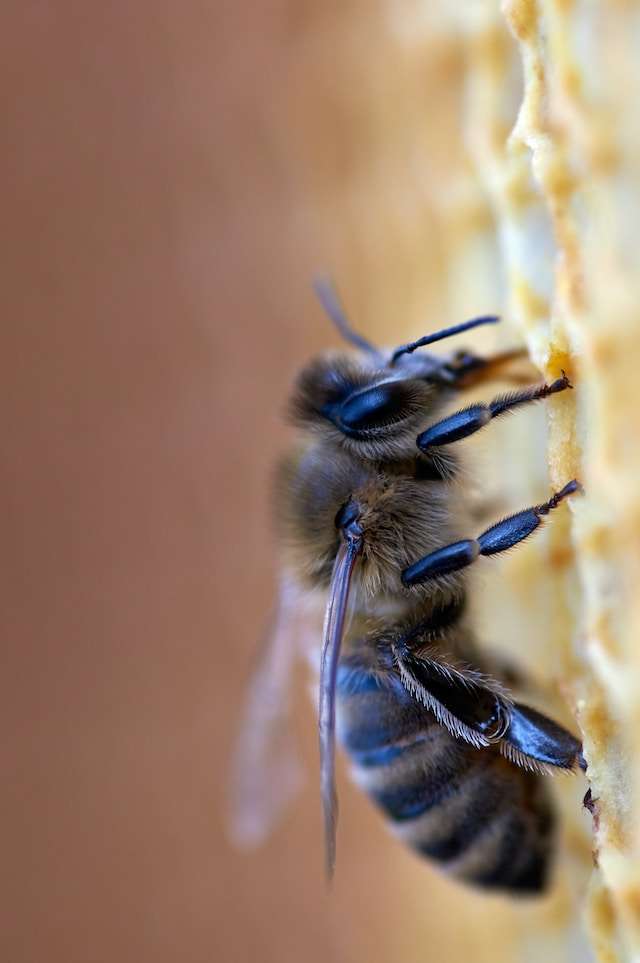
External feeders, as the name suggests, are positioned outside the hive. Although these feeders require additional protection and may attract unwanted attention, they serve their purpose under specific circumstances. Let’s explore further:
- Description and Purpose:
External feeders are placed outside the hive, often at a distance to avoid congestion near the entrance. They are particularly useful when alternative feed sources are scarce or to encourage foraging in specific locations, such as during pollination services.
- Pros and Cons:
The benefits of external feeders include minimal disturbance to the hive during refilling, ease of access for beekeepers, and the ability to provide feed to multiple colonies simultaneously.
However, these feeders are at greater risk of attracting pests, such as wasps or ants, and may contribute to robbing behavior among bees.
Popular Subtypes:
- Entrance Feeders: Positioned directly at the hive entrance, these feeders offer easy access for the bees but can increase the likelihood of attracting unwanted pests. They are often used for short-term feeding.
- Bucket Feeders: External buckets or containers filled with syrup can be placed near the hives. These feeders allow for larger volumes of feed, reducing the frequency of refilling. However, they require proper protection from drownings and robber bees.
- Top Bar Feeders: Positioned above the hive, top bar feeders offer a convenient solution for feeding multiple colonies simultaneously. However, they must be carefully protected from pests and adverse weather conditions.
Feeding Method
Open Feeding
- Description and purpose
Open feeding is a method of providing honey bees with food in a way that allows multiple colonies to access the feeder simultaneously. It involves placing large quantities of food, such as sugar syrup or pollen substitute, in open containers or trays.
The purpose of open feeding is to provide nourishment to honey bees when natural forage is limited, helping them survive during times of scarcity.
- Pros and cons
One of the advantages of open feeding is its simplicity. It requires minimal equipment and can be easily set up, making it an accessible option for beekeepers of all levels of experience. Open feeding also allows multiple colonies to feed together, promoting inter-colony interactions and potentially strengthening the overall bee population.
However, there are some drawbacks to open feeding. Firstly, it can attract unwanted pests such as wasps, ants, and other insects, which may cause disruptions or even harm to the honey bee colonies. Additionally, the large quantities of food provided through open feeding can lead to rapid consumption, resulting in wastage and potential overfeeding.
- Risks and potential drawbacks
While open feeding can play a crucial role in helping honey bees overcome periods of food scarcity, there are risks associated with this feeding method. One significant risk is the potential spread of diseases.
When multiple colonies feed together, there is an increased risk of disease transmission between colonies, which can devastate bee populations if adequate precautions are not taken. Therefore, regular inspections and monitoring are essential to ensure the health of the colonies involved in open feeding.
Restricted Feeding
- Description and purpose
Restricted feeding, as the name suggests, involves providing honey bees with food in a controlled and limited manner. This is typically done using specialized feeders that restrict access to the food source, allowing only a few bees at a time to feed.
The purpose of restricted feeding is to ensure that the food supply is efficiently distributed among the colony members, preventing wastage and promoting optimal consumption.
- Pros and cons
One of the main advantages of restricted feeding is its ability to minimize food wastage. By controlling the flow of food, beekeepers can ensure that the available nourishment is utilized effectively, reducing the risk of overfeeding or attracting pests.
Restricted feeding also allows for more accurate measurement of the amount of food consumed, aiding in monitoring the health and progress of the colonies.
However, restricted feeding requires the use of specialized feeders, which can be more costly and complex than open feeding methods. Beekeepers need to invest in suitable feeders that provide controlled access while preventing contamination or spillage.
Additionally, restricted feeding may lead to increased competition among bees, as only a limited number can access the food source at a time, potentially causing stress within the colony.
- Risks and potential drawbacks
While restricted feeding offers benefits such as efficient food utilization and improved monitoring, there are risks associated with this method as well.
One potential drawback is the potential for robbing behavior, where neighboring or weaker colonies attempt to steal food from the feeder. This can lead to aggressive bee interactions, colony conflicts, and potential colony loss if not managed properly.
Therefore, careful observation and timely intervention are crucial to prevent robbing and maintain colony harmony during restricted feeding.
Hive Top Feeders
Hive Top Feeders are designed to sit on top of the beehive, allowing bees to access the syrup or feed without having to leave the colony.
- Description and Purpose:
Hive Top Feeders typically consist of a container or reservoir with an extended platform that fits over the hive. The container holds the syrup or feed, which is then available through small openings or channels that allow bees to access it.
The purpose of Hive Top Feeders is to provide a large quantity of food to the bees while minimizing disturbance to the hive. By placing the feeder on top, it reduces the risk of robbing or attracting other unwanted insects.
Pros:
- Can hold a significant amount of feed, reducing the frequency of refills.
- Minimizes disturbance to the colony.
- Reduces the risk of robbing.
Cons:
- May require additional equipment or modifications to the hive.
- Requires regular maintenance and cleaning to prevent mold or fermentation.
- Bees may require additional time to locate the feeder initially.
Suitable Situations for Use:
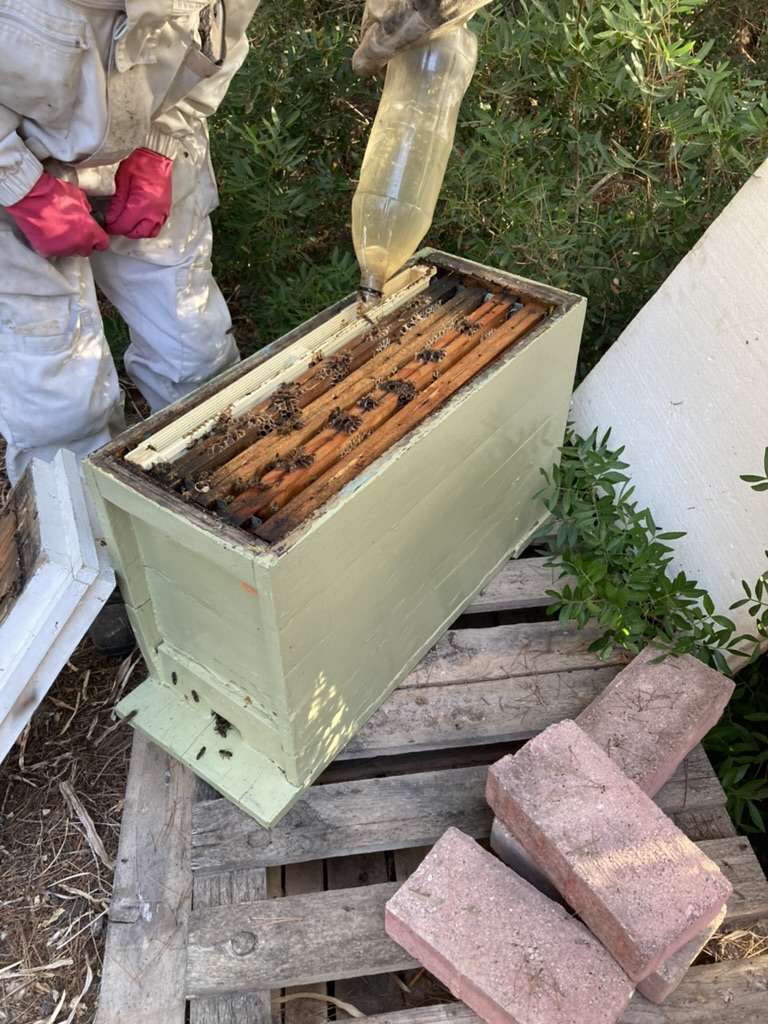
Hive Top Feeders are most suitable in situations where minimal disturbance to the hive is desired, such as during the colder months or when colonies need a quick boost of nutrients.
Additionally, they are beneficial in areas with a higher risk of robbing or when large quantities of feed are necessary.
Entrance Feeders
Entrance Feeders are designed to be attached to the entrance of the beehive, allowing bees to access the feed directly.
- Description and Purpose:
Entrance Feeders typically consist of a small container or reservoir with an opening that attaches to the entrance of the beehive. The container holds the syrup or feed, which bees can access directly from the entrance.
The purpose of Entrance Feeders is to provide a straightforward and easily accessible feeding solution for the bees. This type of feeder allows for quick refilling and monitoring of feed levels.
Pros:
- Easy to install and refill.
- Provides direct and immediate access to feed.
- Allows for convenient monitoring of feed levels.
Cons:
- May increase the risk of robbing and attracting other insects.
- Requires regular maintenance and cleaning.
- Smaller capacity, necessitating more frequent refills.
Suitable Situations for Use:
Entrance Feeders are well-suited for situations where frequent monitoring and easy access for refilling are important. They are commonly used during warmer months when colonies require smaller quantities of feed and are less prone to robbing.
Frame Feeders
Frame Feeders are designed to fit directly within the beehive, in place of regular honeycomb frames, for easy access to feed.
- Description and Purpose:
Frame Feeders resemble regular honeycomb frames but have a reservoir or container built into them that can hold syrup or feed. These feeders fit securely within the hive, allowing bees to access the food alongside the frames.
The purpose of Frame Feeders is to provide a convenient and discreet feeding solution, integrating seamlessly within the hive structure.
Pros:
- Discreet and integrated within the hive.
- Can hold a moderate amount of feed.
- Easy to monitor and maintain.
Cons:
- May require modifications to accommodate frame feeders.
- Can interrupt the arrangement of honeycomb frames.
- Refilling may require some disruption to the colony.
Suitable Situations for Use:
Frame Feeders are suitable for situations where discreet feeding within the hive is desired, especially during times when colonies require larger quantities of feed. They are commonly used during periods of nectar scarcity or when colonies need supplemental nutrition to support their growth and honey production.

Factors to Consider When Selecting a Honey Bee Feeder
There are four key factors to consider when selecting a honey bee feeder: colony size and strength, weather and environmental conditions, beekeeper’s experience and preferences, as well as cost and maintenance requirements.
Colony Size and Strength:
- Assessing bee population: Before choosing a feeder, it is important to consider the size and strength of your bee colony. Evaluate the number of bees in your hive to determine the appropriate feeder capacity.
- Feed consumption rate: Understand the consumption rate of your colony. A larger colony will consume more feed, so you may need a feeder that can accommodate larger volumes or requires less frequent refilling for efficient feeding.
Weather and Environmental Conditions:
- Climate considerations: The local weather and environmental conditions play a significant role in selecting the right honey bee feeder. Depending on your climate, you will need to choose a feeder that can withstand extreme temperatures, heavy rain, or high winds to ensure the safety and comfort of your bees.
- Accessibility to feed: If your area experiences colder temperatures, choose a feeder that allows easy access to the feed without exposing bees to excessively cold conditions. Feeder options that minimize bee exposure to cold air while accessing the feed can help maintain colony health during winter months.
Beekeeper’s Experience and Preferences:
- Beekeeper skill level: Consider your experience as a beekeeper when selecting a honey bee feeder. Some feeders may require more technical knowledge or regular monitoring, which might be suitable if you are an experienced beekeeper. Beginners may need a simpler and user-friendly option.
- Feeder compatibility: Different hive types and management systems may require specific feeders. Ensure the selected feeder is compatible with your hive design and fits snugly to avoid any interruptions in the hive structure.
Cost and Maintenance Requirements:
- Cost considerations: Evaluate the cost of the feeder and consider your budget. Keep in mind that cheaper feeders may compromise on quality, durability, or functionality. It is important to strike a balance between quality and affordability.
- Maintenance needs: Determine the maintenance requirements of the feeder before making a purchase. Some feeders may require more frequent cleaning, refilling, or replacement of parts, while others may be more low-maintenance. Consider your available time and resources when deciding on the feeder’s maintenance level.
Tips for Using Honey Bee Feeders Effectively
Here are chapter some valuable tips to optimize the placement and timing of your feeders, as well as techniques for monitoring feed consumption and maintaining cleanliness to prevent contamination.
Placement and Timing:
Strategic Location:
- Place feeders close to the center of the hive cluster, preferably over the brood chamber, to attract bees to the feed source.
- Ensure the feeder is easily accessible, and there are no obstructions preventing bees from accessing the feed.
- Position feeders in a shaded area to prevent excessive heat or direct sunlight, which could alter the quality of the feed.
Nectar Scarcity:
- Evaluate the availability of natural nectar sources in your area before deciding when to use feeders.
- Introduce feeders when nectar is scarce, such as during periods of drought, or before and after long-distance transportation of colonies.
- Consider local weather conditions and flowering patterns to ensure your feeders provide adequate nutrition when needed most.
Monitoring Feed Consumption
Regular Inspection:
- Check the feed levels in your feeder regularly to ensure a steady supply for the bees.
- Monitor the uptake rate to effectively gauge the colony’s needs and adjust the quantity of feed accordingly.
Observation Techniques
- Use transparent or translucent feeders to allow easy visual inspection of the feed levels without disturbing the bees.
- Observe bee activity around the feeder – a large number of bees, active foragers, and quick consumption indicate a need for more feed.
Maintaining Cleanliness and Preventing Contamination
Sanitization:
- Regularly clean and sanitize your feeders to prevent the growth of mold, fermentation, or transmission of diseases.
- Clean feeders thoroughly using mild soap and warm water before refilling them with fresh feed.
Proper Storage and Handling:
- Store unused feed properly in airtight containers and a cool, dry place to maintain its nutritional quality.
- Avoid using contaminated utensils or feeders by keeping them clean and separate from other tools or substances.
Conclusion
Honey bee feeders are invaluable tools for beekeepers, helping ensure the health and well-being of their colonies. By providing supplemental nutrition during times of scarcity, feeders play a critical role in sustaining strong, productive honey bee communities.
Choosing the right type of feeder, such as division board feeders, top feeders, entrance feeders, or frame feeders, depends on various factors such as colony size, convenience, and parasite risks.
By understanding these different types of feeders and using them effectively, beekeepers can support their honey bee colonies, promote robust hive growth, and enjoy the sweet rewards of their efforts.
Frequently Asked Questions (FAQ) About Beekeeper Honey Bee Feeders
How does a honey bee feeder work?
- A honey bee feeder typically consists of a container or reservoir capable of holding liquid or solid food, which is easily accessible to the bees. It may have small openings or feeding channels that allow the bees to consume the feed, while certain designs ensure minimal drowning risks. Beekeepers place the feeder near the hive, providing the bees easy access to the food without interrupting their natural foraging behavior.
What types of honey bee feeders are available for beekeepers?
- There are various types of honey bee feeders available for beekeepers to choose from, including entrance feeders, top feeders, frame feeders, bucket feeders, and division board feeders. Each type differs in design and placement options, allowing beekeepers to select the most suitable feeder for their specific hive management needs.
What are the advantages of using a honey bee feeder?
Using a honey bee feeder offers several benefits to beekeepers, including:
- Prevention of colony starvation during periods of low nectar flow or early hive establishment.
- Enhanced colony growth and development.
- Ability to provide supplementary feed that meets the bees’ nutritional requirements.
- Easy monitoring of feeding activity and consumption.
- Reduced competition from other insects attracted to spilled or exposed feed.
- Facilitation of disease management through controlled feeding.
Are honey bee feeders safe for the bees?
- When used correctly and maintained properly, honey bee feeders are safe for the bees. However, some precautions should be taken, such as ensuring the feeder design minimizes drowning risks, regularly cleaning the feeder to prevent contamination, and selecting appropriate feed types that are safe for honey bees.
What kind of food is suitable for honey bee feeders?
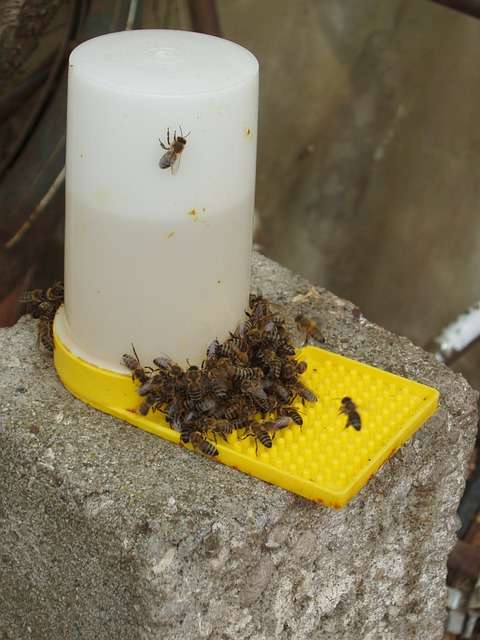
- Honey bee feeders can accommodate various types of feed, including sugar syrup, fondant, pollen substitute, and specialized bee feed mixes available in the market. It is important to choose a feed that matches the bees’ dietary needs and uses high-quality ingredients that promote their health.
Can honey bee feeders attract other unwanted pests?
- While honey bee feeders primarily attract honey bees, they can also attract other insects and pests, such as wasps, ants, and occasionally, bears. To minimize unwanted guests, beekeepers should select feeders with features like bee-guard screens and place them in strategic locations away from potential pest attractants.
How often should I refill the honey bee feeder?
- The frequency of refilling honey bee feeders largely depends on the size of the colony, their nutritional needs, and external factors. During periods of heavy feeding or nectar dearth, it is advisable to check and refill the feeders every 2-3 days, ensuring a continuous supply of food for the bees.
Can I use multiple honey bee feeders in one hive?
- Yes, beekeepers can use multiple feeders in a single hive, especially for larger colonies. Placing feeders on opposite sides of the hive helps reduce overcrowding and allows more even distribution of bees during feeding. Care should be taken not to overwhelm the bees and maintain appropriate access to the feeders.
Where can I purchase honey bee feeders?
- Honey bee feeders can be purchased from various sources, including local beekeeping supply stores, online beekeeping equipment retailers, and agricultural supply centers. Additionally, it is beneficial to consult experienced beekeepers or join beekeeping associations for recommendations on reliable suppliers.
